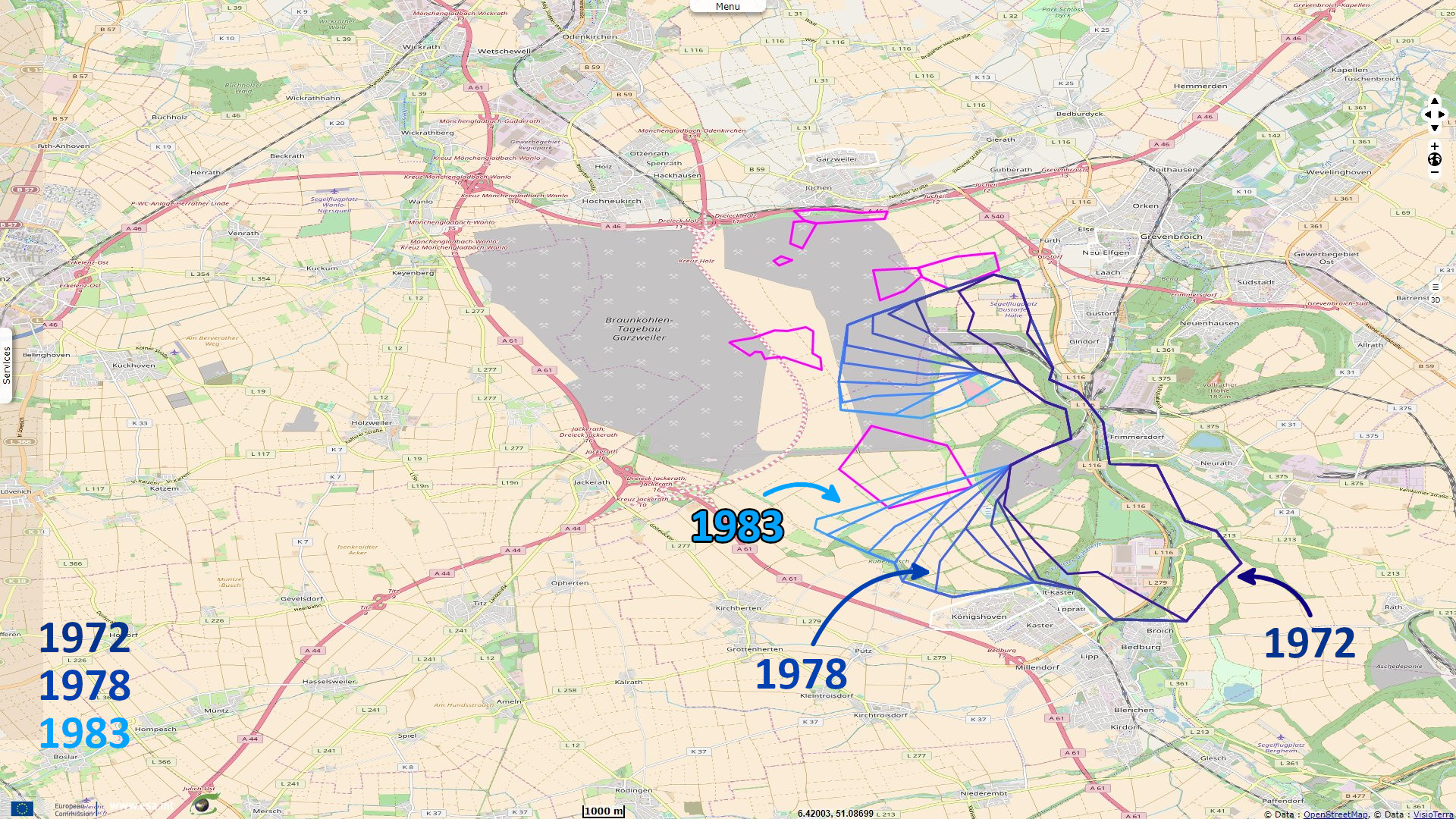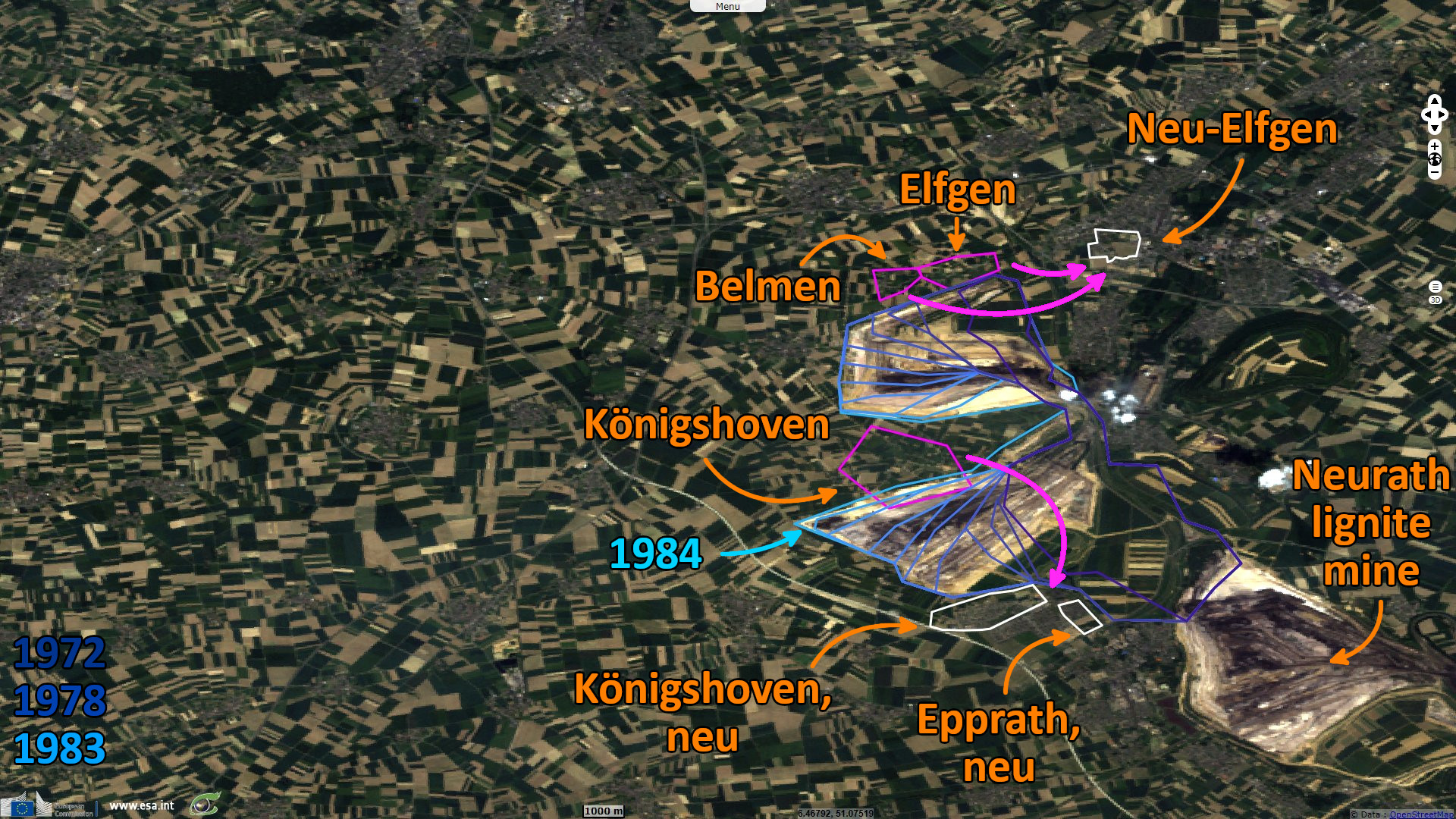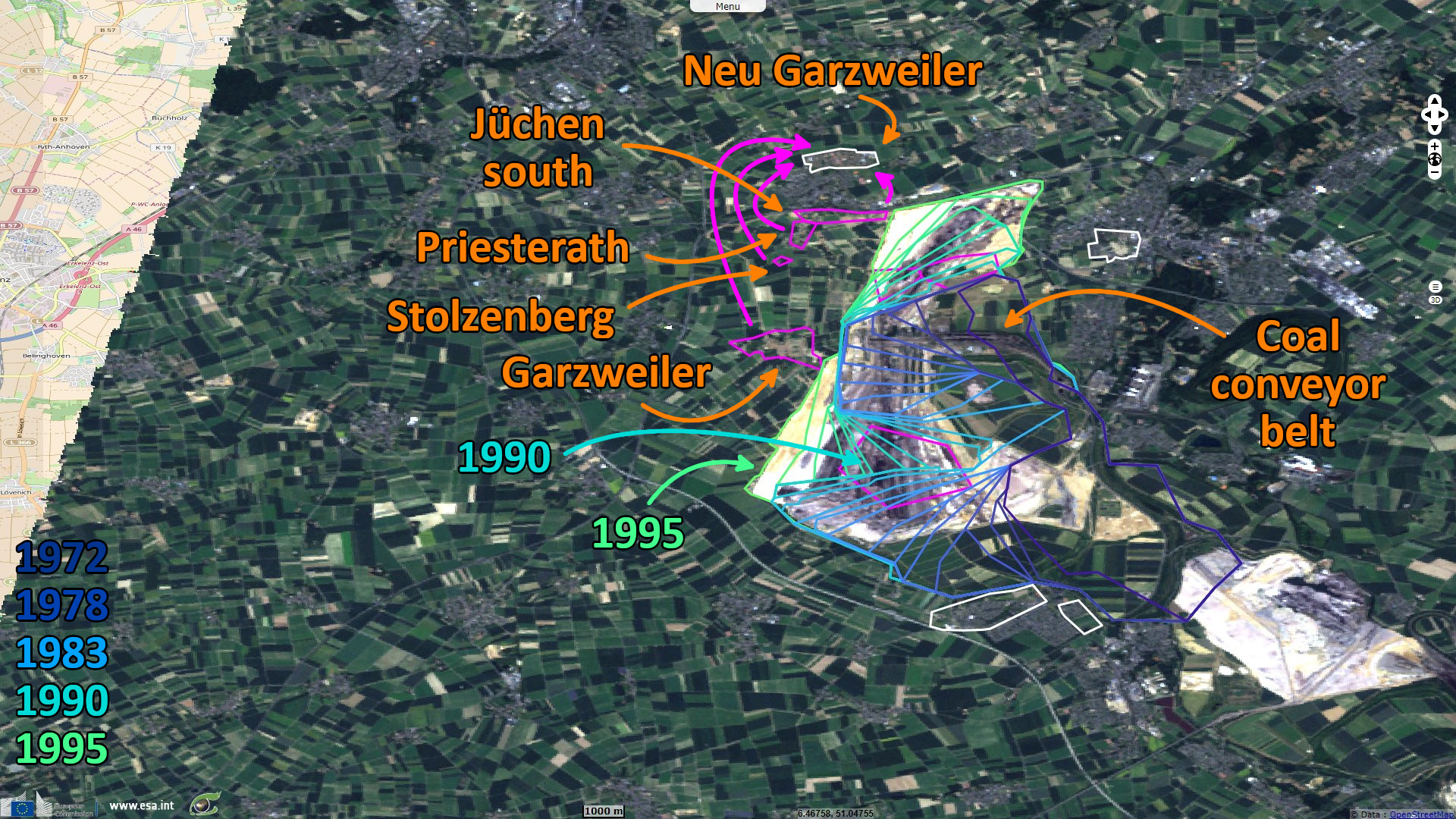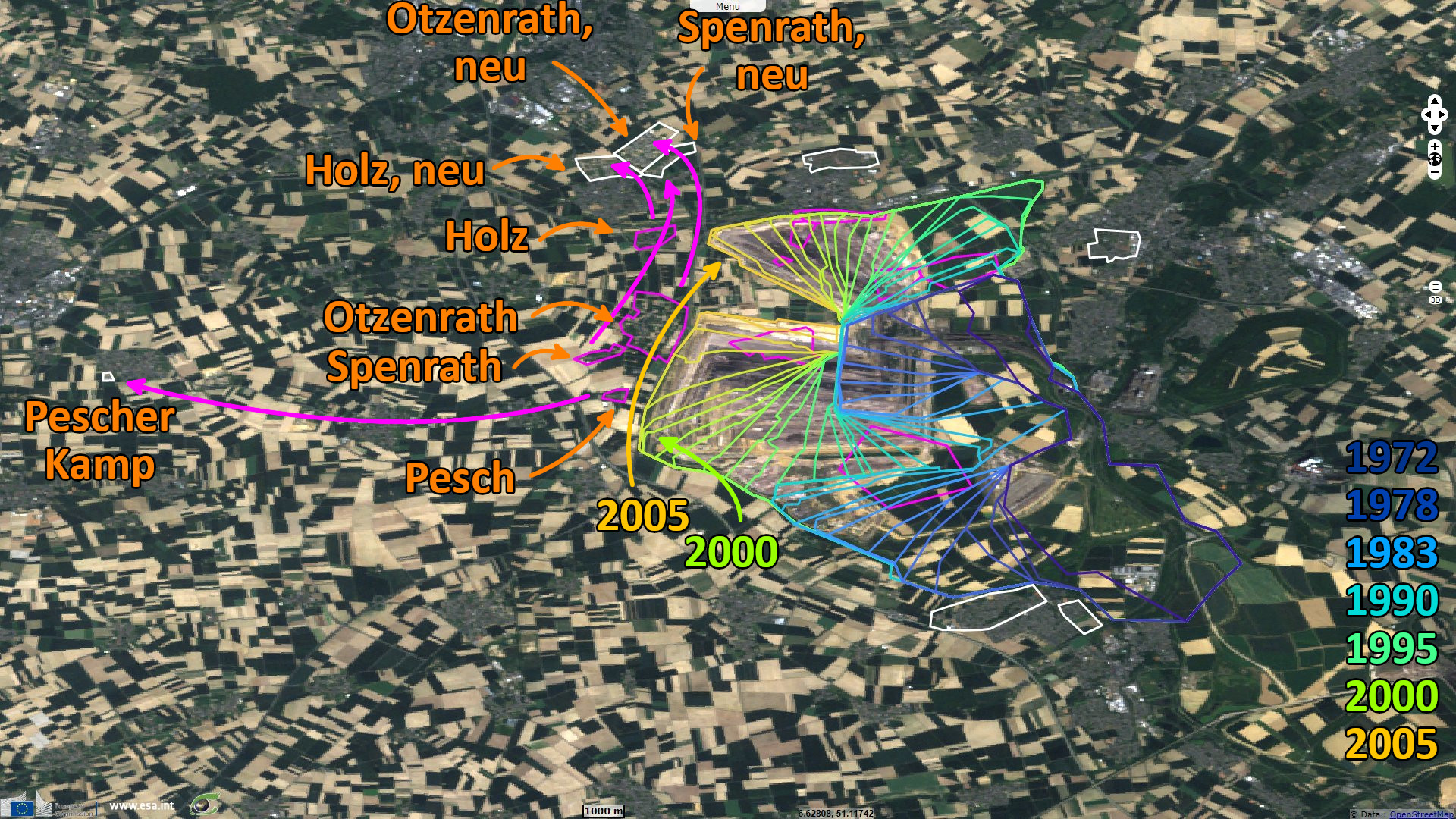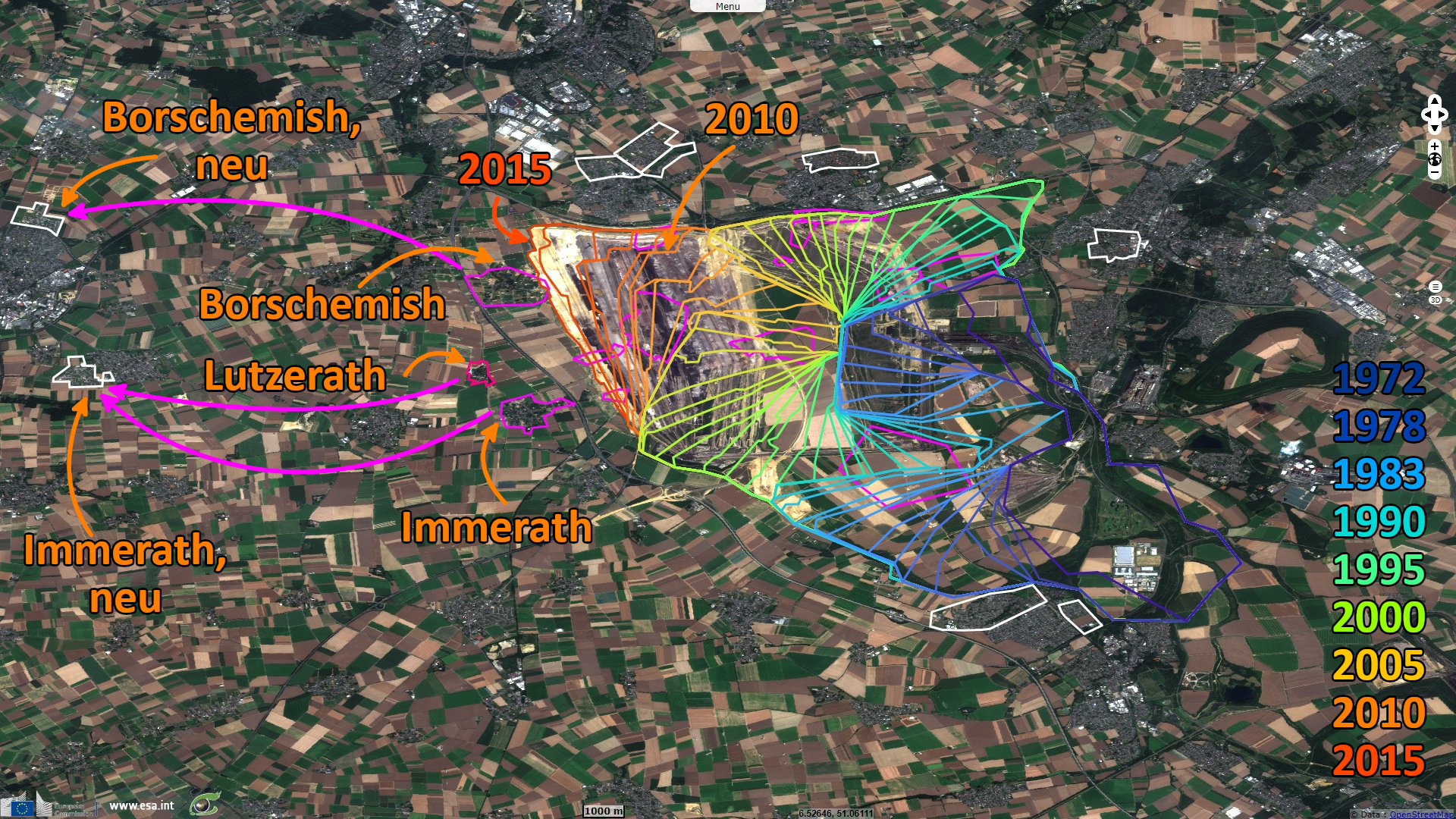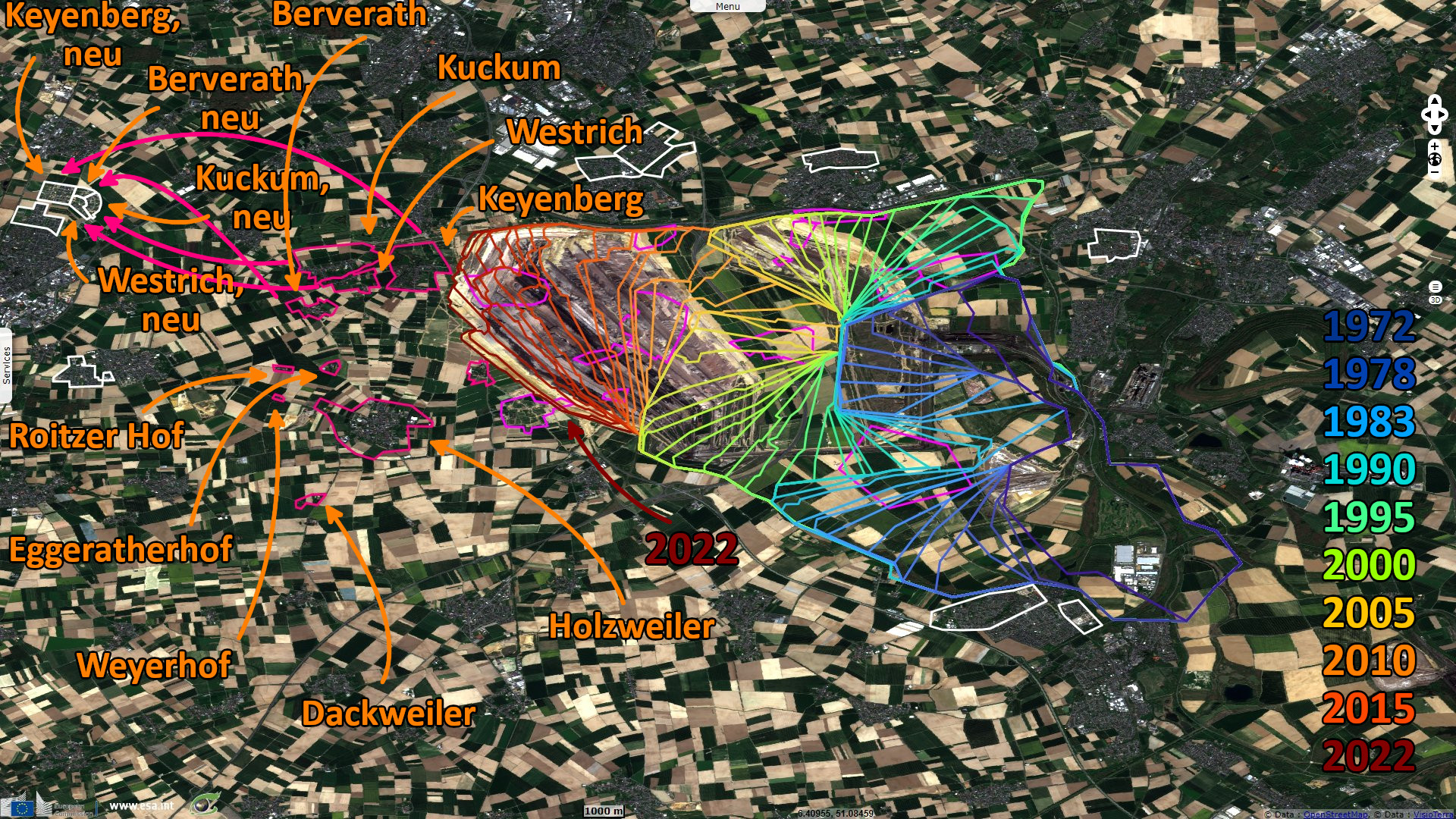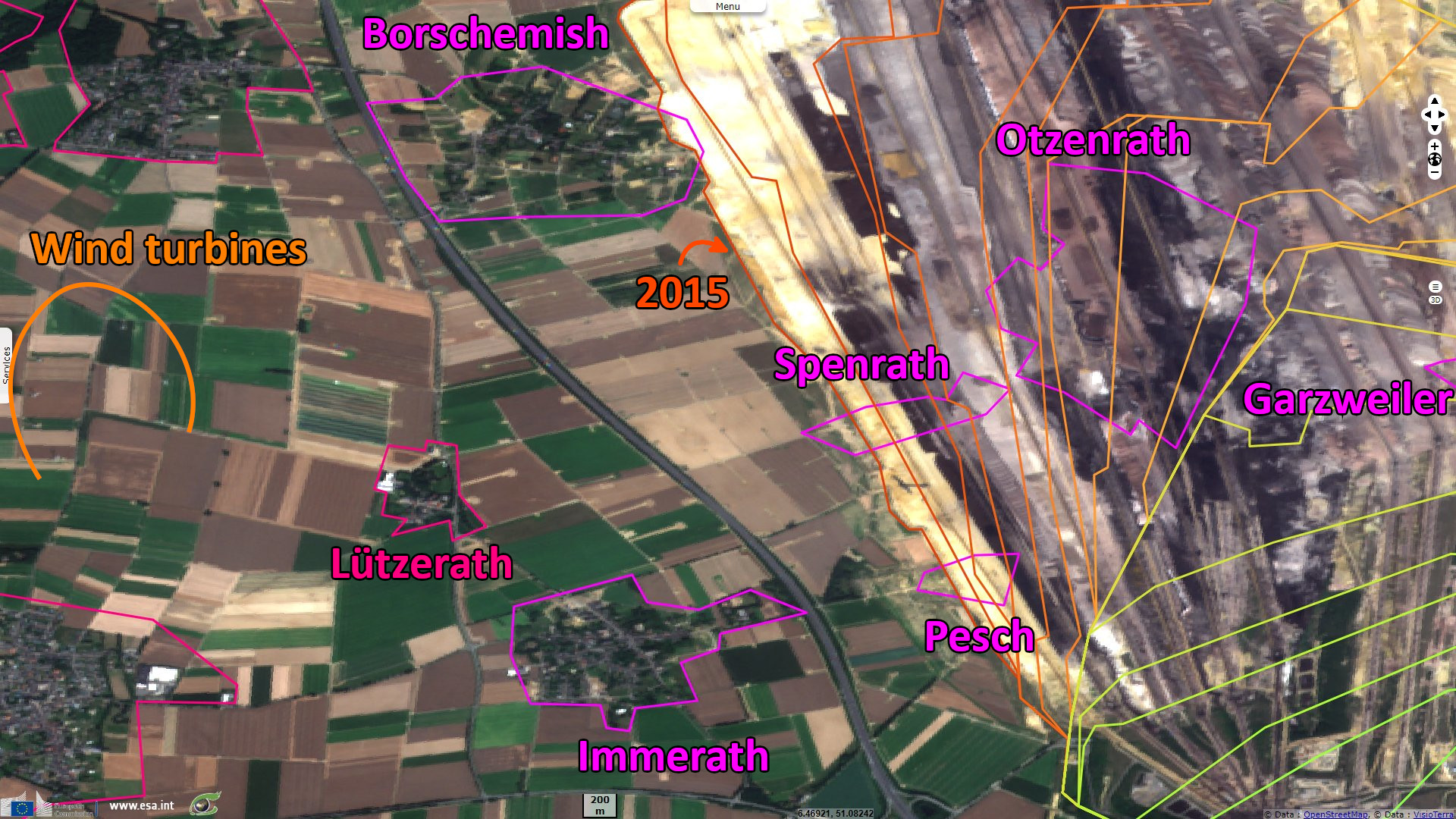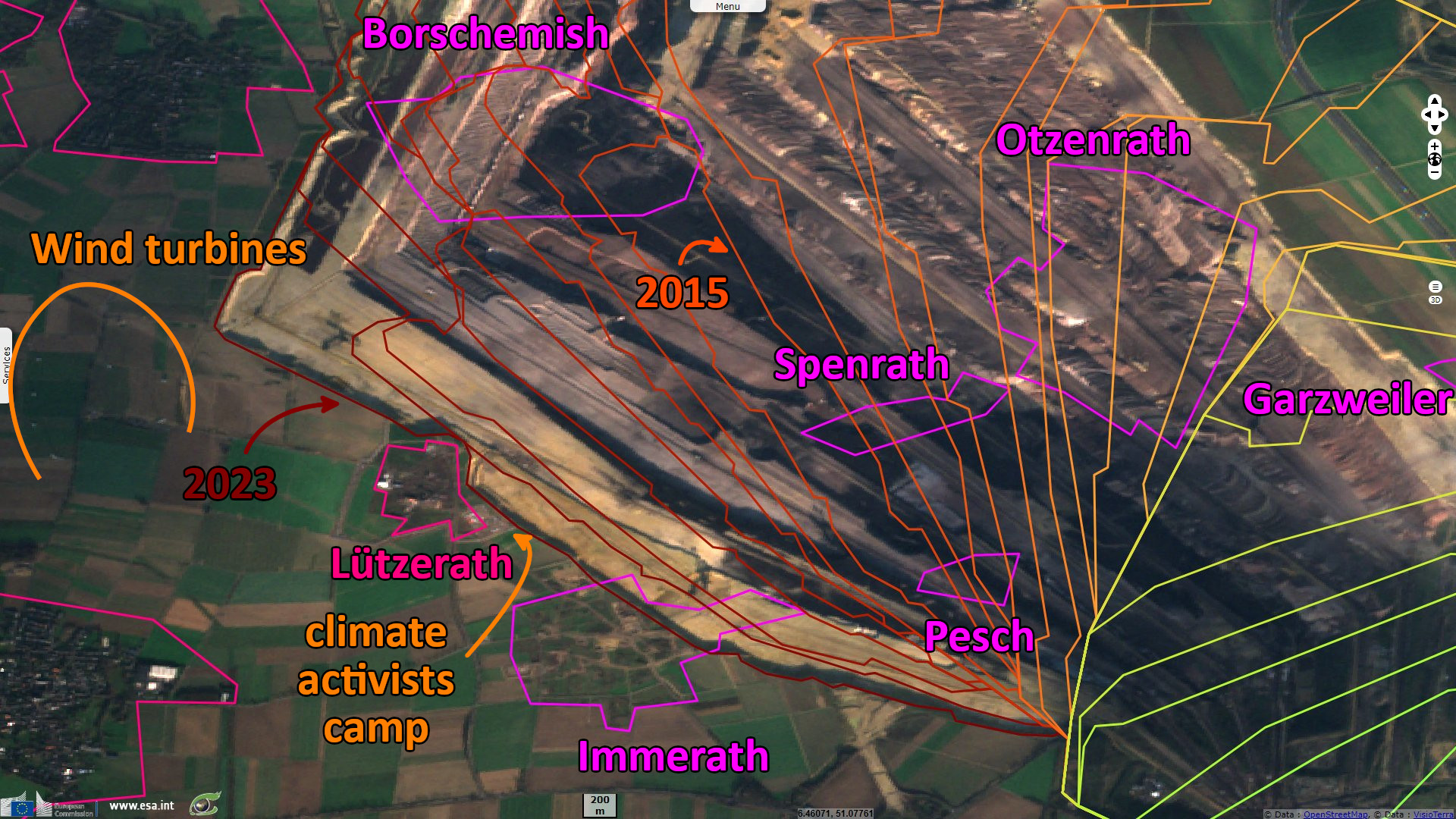Garzweiler open pit, the German lignite mine that devours cities
Landsat TM acquired on 19 June 1984 at 09:55:49 UTC
...
Sentinel-2 MSI acquired on 02 August 2015 at 10:40:26 UTC
Sentinel-2 MSI acquired on 17 January 2023 at 10:42:59 UTC
Sentinel-1 CSAR IW acquired on 18 January 2023 at 05:50:33 UTC
...
Sentinel-2 MSI acquired on 02 August 2015 at 10:40:26 UTC
Sentinel-2 MSI acquired on 17 January 2023 at 10:42:59 UTC
Sentinel-1 CSAR IW acquired on 18 January 2023 at 05:50:33 UTC
Keyword(s): Land, natural resources, coal mining, coal power, energy, climate change, global warming, greenhouse gas emissions, ghg, air pollution, urban planning, Germany
Facing multiples constrains to reduce energy production from hydrocarbon (coal in the first place) and nuclear in a short time frame, "Electricity generation in Germany has been declining for years", notes Strom Report.
It is in the nuclear phase-out that Germany has taken the strongest actions, reminded Clean Energy Wire in a 2021 article: "Germany wants to curb greenhouse gas emissions but at the same time will shut down all of its nuclear power stations, which in the year 2000 had a 29.5% share of the power generation mix. In 2020 the share was down to 11.4%, and by 2022 all nuclear plants are going to be shut down. The country is pursuing the target of filling the gap with renewable energy."
Angela Merkel became Chancellor after Gerhard Schroeder (who then has worked for Russian state-owned energy companies, including Nord Stream AG, Rosneft, and Gazprom), causing a change in the strategy, relates the BBC: "When the CDU/CSU won the elections in 2009 and formed a coalition with the Free Democrats (FDP), they extended the operating time by eight years for seven nuclear plants and 14 years for the remaining ten." But "in the wake of the nuclear catastrophe in Fukushima, Japan, on 11 March 2011, the same Merkel government decided on 14/15 March to suspend the 2010 lifetime-extension."
In the context of the war in Ukraine, the Chancellor Olaf Scholz gave a short extension to nuclear power, completes the Centre for Eastern Studies (OSW): "On 11 November the Bundestag adopted a draft amendment to the nuclear which allows the three nuclear power plants still in operation in Germany to continue operating until 15 April 2023 at the latest. The decision is justified as a reaction to the current energy crisis in Europe caused by Russia’s aggression against Ukraine, and is intended to contribute to securing electricity supplies for Germany during the upcoming winter."
Germany successfully cut its reliance on nuclear power between 1990 and 2022 (from 28% to 6%) and reduced its production from brown and hard coal (from 56%, still at 31%). Yet by focusing on one task at a time, it could have almost removed coal from its energy mix.
Germany managed to increased renewables (from 4% to 44%) to a level similar to that of carbon-based energy.
It had to fill the gap by adding gas in its energy mix (6% to 16% in 2021). The Turkish new agency Anadolu Agency wrote in 2019: "The Nord Stream 2 natural gas pipeline project plays a crucial role in offsetting the diminishing share of nuclear and coal in Germany’s energy mix. At the same time, the project also serves to compensate for the declining level of natural gas production in Western Europe. However, the project is encountering opposition from some European countries, which are concerned about a potential increase in EU reliance on Russian natural gas."
Nord Stream 2 was completed but never opened. It was sabotaged on 26 September 2022, undermining the German supply of methane added OSW: "Due to Germany's complete cut-off from Russian gas supplies, which cannot be fully replaced in the short term, it will be much harder to replenish its storage facilities before next winter than it has been this year."
"Germany, one of the world’s biggest consumers of coal, will shut down all 84 of its coal-fired power plants over the next 19 years [before end 2038] to meet its international commitments in the fight against climate change" according to the Los Angeles Times. "Powerful utilities and labor unions helped keep coal-burning plants operating and previous governments even planned to expand the number of coal plants to compensate for the pending withdrawal from nuclear power. There are still about 20 000 jobs directly dependent on the coal industry and 40 000 indirectly tied to it."
Attempts to halt the coal industry "got more complicated after Russia's invasion of Ukraine triggered an energy crisis in Europe."
raises die Deutsche Welle. Prior to the escalation of the war in Ukraine in 2022, Germany depended on Russian imports for about a third of its oil and nearly half of its hard coal. "Cut off from Russian natural gas, Germany has scrambled to secure an alternative energy supply. That included crawling back to its homegrown coal industry", ie lignite mines, the least efficient and most polluting form of coal. "This year, the government has moved to bring around a dozen plants back on the grid, and extended the lifespan of several that were meant to be shuttered."
On the mining side, Arne Müseler explains the mining history of Garzweiler open pit lignite mine: "Lignite is or was mined in numerous European countries, but also, for example, in Australia and the USA. Germany is at the top of the lignite producing countries, ahead of China and Russia. In Germany there are three large areas with active opencast mines. The Central German lignite mining area near Leipzig, the Lusatian mining area near Cottbus and the Rhenish lignite mining area near Cologne and Düsseldorf."
Coal mining in the region began in the middle of the 19th century. Open pit mines at the beginning of the 20th century. Around 1960, the Neurath pit merged with the Frimmersdorf pit to the west, which was also owned by the Rheinische Braunkohlenwerke. The pits were combined and the opencast mine continued westward under the new name Frimmersdorf-Süd, which later in turn became the Garzweiler opencast mine. In the south, the Fortuna-Garsdorf open-cast mine later grew to the limit of the Neurath open-cast mine, which had been closed for a long time at that time.
Garzweiler I affects a 66 km² area east of the original route of the A44 motorway, the Garzweiler II mining area concerns an area directly west of Garzweiler I including the original Autobahn route and is 48 km² in size (originally, an area of 68 km² was planned).
Around 300 towns in Germany have been demolished for lignite mining, causing more than 120 000 people to be resettled. Arne Müseler reports the consequences on the population that lives on land to-be-mined: "Between 2006 and 2038, 12 towns near Düsseldorf are to be completely demolished. Beneath the villages lies lignite. Unlike the hard coal in the Ruhr region, this coal is not mined underground (“underground”), but above ground in the form of an open-cast mine (“above ground”). With this form of mining, everything that stands in the way of open-pit mining is inevitably destroyed. Not only the houses are demolished, but also churches, cemeteries, monuments, trees, streams and forests.
Entire towns have been and are being dredged for opencast mining. Residents have to have their houses and properties appraised by an appraiser and then sell them to RWE. If they don't sell, they can be expropriated."
Die Tagesschau relays the fate of the Lützerath settlement, the next in the path of the mine: The coal under the former Lützerath settlement, in the immediate vicinity of the opencast mine, is needed to operate the lignite at high capacity during the energy crisis and at the same time to obtain sufficient material for high-quality recultivation, RWE announced.
The necessary permits and court decisions for this are in place, and all of the original residents have already left the site. Environmentalists had demanded that the brown coal not be mined under Lützerath. The opencast mine has moved close to the site in recent months. According to RWE, the towns of Keyenberg, Kuckum, Oberwestrich, Unterwestrich and Berverath will remain. Residents do not need to be relocated.
The two federal and state economics ministries led by Greens have agreed with the energy company RWE that five villages will remain in the opencast mine, relates Der Spiegel. Furthermore the phase-out of lignite in the Rhenish mining area will be brought forward to 2030 , i.e. eight years earlier than originally planned. 280 million tons of coal would remain in the ground, the CO2 balance would be significantly improved. Finally, RWE wants to invest more than 50 billion euros worldwide by 2030 to accelerate the energy transition.
Lützerath, a town south of Mönchengladbach, has been relocated by RWE for opencast mining since 2006. According to the compromise, it is to be dredged for energy production. None of the original villagers live there anymore, their houses and courtyards initially remained empty, then climate activists occupied the settlement. Lützerath has become their place of pilgrimage, one of their most important arenas in the fight for the 1.5 degree target. If the village is to give way, the police are likely to evict it, similar to 2018 in the Hambach Forest. The clearing of a protest camp in the forest was subsequently classified as illegal in court.
"Hundreds of officers cleared around 300 activists from Lützerath in an operation that began on Wednesday 13 January." Climate activist Greta Thunberg was among climate activists detained during protests against the demolition of the coal village of Luetzerath on Tuesday, according to police. "The climate organisers said around 35 000 protesters demonstrated on Saturday 14 January, while police officials put the figure at around 15 000.", BBC indicated.
"But it's not just about saving the town, people opposing the demolition say. It's about keeping coal in the ground. Globally, coal is still the largest source of electricity generation as well as the largest source of carbon dioxide." adds die Deutsche Welle. "Protesters argue that the early phaseout doesn't matter: burning the coal below Lützerath will cause Germany to overshoot its CO2 emissions targets. It's a claim backed up by the German Institute for Economic Research (DIW)."
The largest Bagger bucket-wheel excavators are 93 m tall, 225 m long, weighs 14 200 T and capable of moving 240 000 m3 of overburden every day.

